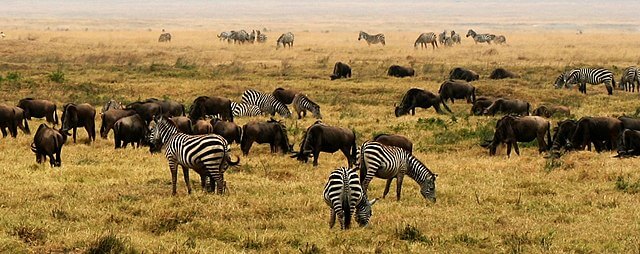Mont-Africa
By Camille Barr
Broadcast 3.2009, 5.2014, and 3.15 & 3.18.2023

Zebras and wildebeests graze in the Ngorongoro Crater in Tanzani. Photo by Flickr user Gaurav P, CC by 2.0.
Listen:
Montana. It’s like no other place on Earth. With wide, grassy plains, big skies, herds of mammals, large predators, and a rugged attitude, who else can claim such a collection of amazing and unique features?
Actually though, Montana is like somewhere else on Earth, but somewhere you may not at all expect…and that place is Africa.
While it may seem inconceivable that Africa can have any relation to Montana, the two places share a number of features that most other places can’t match.
The first most obvious resemblance is habitat. Africa is well-known for its vast grasslands known as savannas. And Montana isn’t known as Big Sky country for nothing: 34% of our state is rich grasslands, having some of the largest expanses with the least disturbance, and some of the richest species diversity – it is thought that our prairies still contain all the plant species that were here before European settlement.
Africa and Montana are also two locations in the world with extremely high mammal diversity. While Africa has many more large hoofed mammals than anywhere else, for its size, Montana is remarkable in its own diversity ranging from elk to pronghorn antelope to moose. And where you have large groups of large grazing mammals, and the space to hold them, you also get the most captivating of the mammals, the carnivores. Large predators have been reduced in number or driven extinct in most of the world because of hunting by humans or insufficient habitat. However, in Africa, lions and leopards and hyenas abound. And in Montana, not only do we have some of the highest diversity of carnivores in the United States, but we also have the healthiest populations of the rarest of carnivores such as wolves, lynx, and grizzly bears.
Sadly, wild animal numbers in the United States have dropped dramatically since European settlement – in fact, the number of bison prior to the slaughters of the 1800s exceeded that of the famous wildebeest in Africa – but Montana has the honored distinction of being the only place in the lower 48 that still has all the animal species that existed before these settlers arrived.
Africa may reign supreme in sheer mammal numbers, but Montana has an interesting claim that further binds these two regions of the world: the area that includes Montana is the birthplace of many of the mammals that we think of as exclusively African. A number of the species that eventually ended up in Africa, such as camels and zebras, originally diversified in this region of the world, millions of years ago. Fossils of animals that look like zebras and camels have been found in locales as close as Idaho, likely having died out here as the climate cooled or early humans moved in, but persisting in more agreeable climes such as Africa.
With the high numbers of large mammals that compete for resources, and predators that can threaten our own safety, comes another feature that is shared between Montana and Africa – conflicts between animals and humans. In Montana, some of the biggest issues headlining the news are the conflicts between ranchers and environmentalists over, for example, the management of reintroduced wolves to Yellowstone, or the culling of potentially brucellosis-carrying bison.
In Africa, many similar conflicts occur. Elephants, which have received substantial protection in many African countries, come into daily conflict with humans, killing them and their livestock, and destroying their crops. Lions are a constant threat to Masai villagers and to their stock, but despite this threat, it is now illegal for them to be killed by these people whose safety, economic security, and cultural traditions rely on lion-killing.
So while Africa literally is and feels like worlds away from Montana, these worlds are actually quite small, and a revision of the famous song might be in order: Oh give me a home, where the buffalo roam, and the wildebeest and the zebras play…
Every week since 1991, Field Notes has inquired about Montana’s natural history. Field Notes are written by naturalists, students, and listeners about the puzzle-tree bark, eagle talons, woolly aphids, and giant puffballs of Western, Central and Southwestern Montana and aired weekly on Montana Public Radio.
Click here to read and listen to more Field Notes. Field Notes is available as a podcast! Subscribe on Apple Podcasts or wherever you listen to podcasts.
Interested in writing a Field Note? Contact Allison De Jong, Field Notes editor, at adejong [at] montananaturalist [dot] org or 406.327.0405.
Want to learn more about our programs as well as fun natural history facts and seasonal phenology? Sign up for our e-newsletter! You can also become a member and get discounts on our programs as well as free reciprocal admission to 300+ science centers in North America!












